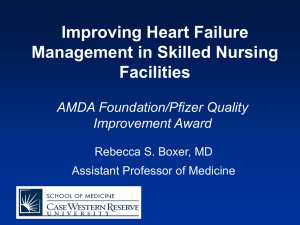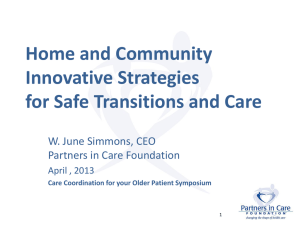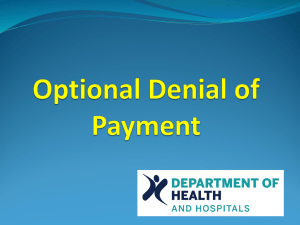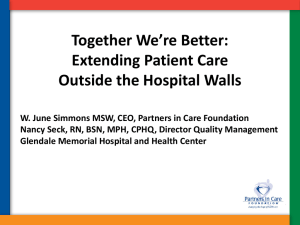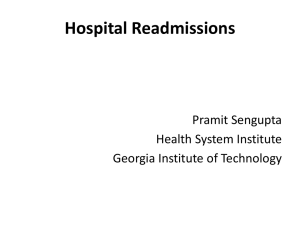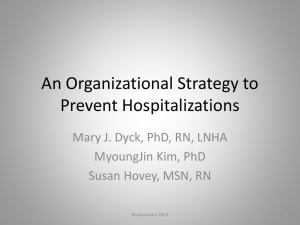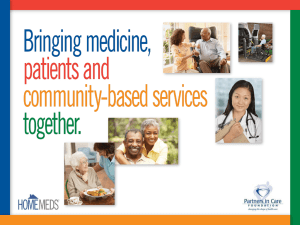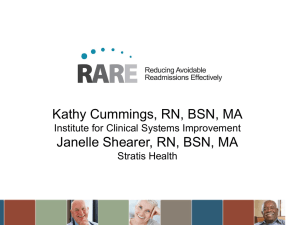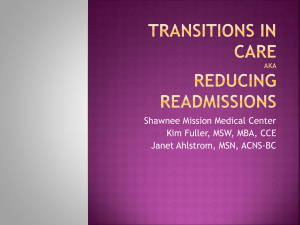Care Models and Opportunities for Social Work, December 19, 2013
advertisement
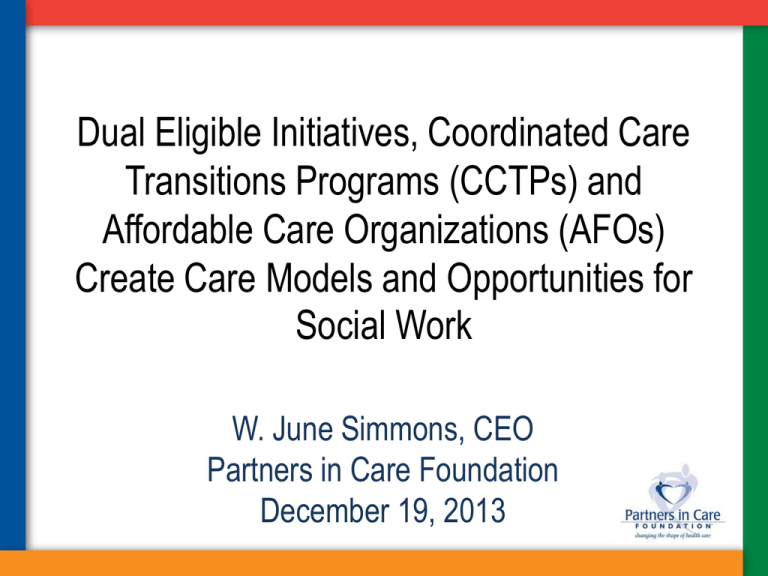
Dual Eligible Initiatives, Coordinated Care Transitions Programs (CCTPs) and Affordable Care Organizations (AFOs) Create Care Models and Opportunities for Social Work W. June Simmons, CEO Partners in Care Foundation December 19, 2013 This webinar series is made possible through the generous support of the Retirement Research Foundation . W. June Simmons, President & CEO Partners in Care Foundation - San Fernando, CA June Simmons, MSW, is the founding President and CEO of Partners in Care Foundation. Ms. Simmons takes an active role in developing initiatives and proactive programs which meet the mutual needs of patient populations, providers and healthcare delivery networks to encourage cost-effective, patient-friendly integration of care from hospital to home and community. Ms. Simmons has just completed a term on the National Advisory Council of the National Institute on Aging (NIA). She is currently a member of the Institute of Medicine Workgroup on Transforming End of Life Care. Partners in Care currently leads innovative initiatives to bring local home and community based organizations into full integrated service delivery systems across our broad regions and addressing the great diversity of our region. A strong leader in bringing forth population health management strategies that integrate medicine and home and community services. 3 Objectives Participants will be able to: • Describe key Affordable Care Act issues impacting social work/long term supports and services practice • Recognize key target populations for social work intervention • Describe central social work strategies and interventions in this changing environment 4 US outcomes are worse – need to spend more wisely The Expanded Chronic Care Model: Integrating Population Health Promotion Targeted Patient Population Management with Increasing Disease/Disability Home Palliative Care End of Life Post Acute and Long Term Supports and Services Hot Spotters! Complex Chronic Illnesses w/ major impairment Chronic Condition(s) with Mild Functional &/or Cognitive Impairment Chronic Condition with Mild Symptoms Well – No Chronic Conditions or Diagnosis without Symptoms Evidence Based SelfManagement, Home Assessment and HomeMeds Inc rea D e si n g F cre asi unctio ng Nu nal o mb r C ers ogn – In itive cre I a si m p a i r ng C o me n t st Targeting Home & Community-Based Services in Active Population Health Management EOL Care Examples: Hospice & home palliative care LTSS/Caregiver Support Examples: SNF diversion, Respite Care, Home Modifications, home monitoring, daily meals, assisted transportation Care Transitions & HomeMeds/Home Support Examples: Coaching & Patient Activation, Home-delivered Meals; Referral to Self-Management Classes Evidence-Based Self-Management for Chronic Conditions Examples : Stanford Healthier Living; Diabetes SelfManagement; Matter of Balance Examples: Activity programs & education @ senior center Congregate Meals, Socialization, Exercise Continuum of Home and Community-Based Services for Older Adults Dual Eligibles – The Ultimate Case Study: Age + Poverty = Worse Health, Higher Cost Sources: Centers for Medicare and Medicaid Services; Kaiser Family Foundation, Medicare Payment Advisory Commission 12 Avoidable Hospitalizations for Duals Over $4 billion potentially avoidable…not to mention the patient suffering this represents Sources: Centers for Medicare and Medicaid Services; Kaiser Family Foundation, Medicare Payment Advisory Commission 13 1% spend 21% 5% spend 50% The Upstream Approach: What would happen if we were to spend more addressing social & environmental causes of poor health? Concentration of Risk • • • • Functional Limitation Dementia Frailty Serious illness(es) Scope of the Problem • 1.7 million Americans die of a chronic disease each year • Chronic diseases affect the quality of life for 90 million Americans • 87% of persons aged 65 and over have at least 1 chronic condition; 67% have 2 or more • 99% of Medicare spending is on behalf of beneficiaries with at least one chronic condition Projected “Boomers” Health in 2030 • More than 6 of every 10 will be managing more than one chronic condition • 14 million (1 out of 4) will be living with diabetes • >21 million (1 out of 3) will be considered obese – Their health care will cost Medicare 34% more than others • 26 million (1 out of 2) will have arthritis – Knee replacement surgeries will increase 800% by 2030 Source:“ When I’m 64: How Boomers Will Change Health Care ”, American Hospital Association, May 2007 Most of Costliest 5% have Functional Limitations http://www.cahpf.org/docuserfiles/georgetown_trnsfrming_care.pdf Dementia and Total Spend • 2010: $215 billion/yr • By comparison: heart disease $102 billion; cancer $77 billion • 2040 estimates> $375 billion/yr Source: Hurd MD et al. NEJM 2013;368:1326-34. Dementia Drives Utilization Dementia No Dementia Medicare SNF use 44.7% 11.4% Medicaid NH use 21% 1.4% Hospital use 76.2% 51.2% Home health use 55.7% 27.3% Transitions 11.2 3.8 Prospective Cohort of community dwelling older adults Source: Callahan et al. JAGS 2012;60:813-20. In case you are not already worried… The Future of Dementia Hospitalizations and Long Term Services+Supports 10 fold growth in dementia related hospitalizations projected between 2000 and 2050 to >7 million. Zilberberg and Tija. Arch Int Med 2011;171:1850. 3 fold increase in need for formal LTSS between now and 2050, from 9 to 27 million. Lynn and Satyarthi. Arch Int Med 2011;171:1852. Because of the Concentration of Risk and Spending, Home and Community Care Principles and Practices are Central to Improving Quality and Reducing Cost Surprise! Home and Community Based Services are High Value • Improves quality: Staying home is concordant with people’s goals. • Reduces spending: Based on 25 State reports, costs of Home and Community Based LTC Services less than 1/3rd the cost of Nursing Home care. This is Our Expertise • Highest risk, highest cost population is ours: functional limitation, frailty, cognitive impairment +/- serious illness • We need a fully integrated service line that also addresses keeping people out of the top 5% Building Our New Business Model: Focus Areas Evidence Based Self-Management Assessments, Care Efficient Delivery System Coordination & Coaching Provider Networks Chronic Disease HomeMeds Evidence-Based Leadership Council Chronic Pain Adult Day/CBAS Assessment Care Coordination Network Diabetes (billable) Home Safety Evaluation Care Transitions Provider Network A Matter of Balance Home Palliative Care Savvy Caregiver Short & Long-Term Care & Service Coordination Powerful Tools for Caregivers Care Transitions Interventions Arthritis Foundation Exercise & Walk with Ease UCLA Early Memory Loss Home and Community Based Services – a Specialty Practice Expertise • Evidence-based approaches underlie all our work • In-Home assessment and supports, long and short term – waivers/ Care Transitions • Caregiver skills and support What is Self-Management? The actions that individuals living with chronic conditions must do in order to live a healthy life. Physical Activity Problem-Solving Medications Planning Family Support Manage Fatigue Communication BetterWorking Breathing with Health Professionals Managing Pain Understanding Emotions Healthy Eating CDSMP: The “Gold Standard” • Improves health and quality of life – Benefits people at all SES and education levels • Reduces health care costs • Improvements and cost savings are sustained over time • Findings documented over 20 years of research in a variety of settings • Offered in many countries and in over 20 languages Some Evidence-Based Programs SELF-MANAGEMENT • Chronic Disease Self-Management • Tomando Control de su Salud • Chronic Pain Self-Management • Diabetes Self-Management Program PHYSICAL ACTIVITY • Enhanced Fitness & Enhanced Wellness • Healthy Moves • Fit & Strong • Arthritis Foundation Exercise Program • Arthritis Foundation Walk With Ease Program • Active Start • Active Living Every Day MEDICATION MANAGEMENT • HomeMeds FALL RISK REDUCTION • Stepping On • Tai Chi Moving for Better Balance • Matter of Balance DEPRESSION MANAGEMENT • Healthy Ideas • PEARLS CAREGIVER PROGRAMS • Powerful Tools for Caregivers • Savvy Caregiver NUTRITION • Healthy Eating DRUG AND ALCOHOL • Prevention & Management of Alcohol Problems New Public and Private Models • Readmission penalties inspiring rapid change • CMS testing new CBO Medicare models • Moving to all cause/all payers • Integrated regional delivery system Goals of Transition Programs • Engage patients (&/or caregivers) with chronic illness and activate self-care & behavior change • Follow post-discharge to ensure meds/services received • Teach/coach regarding medications, self-care, symptom recognition and management • Remind and encourage patients to keep follow- up physician appointments – ensure transportation How to achieve these goals differs across programs Best Practices (Coach focus group) • Identify at-risk patients – Case managers who know patient & family provide fewer, but more appropriate patients – Hospital-based coach who gets to know staff, schedules, how to find patients – staff trusts more and therefore refers more – 24 hours pre-discharge is ideal time • Room Visit – “I’m here on recommendation from”…someone patient knows – MD, case manager • Efficiency – Field coach & hospital coach allows everyone to see more patients – Teamwork gives us more flexibility – cover more times of day and languages Issues/Challenges (Coach focus group) • Identify at-risk patients – Volume (automated at-risk patient ID) vs. quality (case manager – BUSY!) • Have case managers briefly review list for appropriate patients – Timing – often too late; patient already discharged – Weekends! • Room Visit – Patients out of room for tests & treatments, or asleep/too ill • Home Visit – Hard to reach patients – not answering phone; no voicemail system – 48-hour home visit difficult – still too ill and exhausted – Family protects patient & blocks access • Efficiency – We’re bugging case managers for information & they don’t have time – need direct access to face sheet & d/c summary • Patient ID & info has to be exactly right or billing won’t go through • Dx codes not known until d/c summary • We don’t know where pt d/c to (home, SNF, etc) • 30-40% readmitted elsewhere – how do we know? Coleman Care Transition Intervention – Social Worker or Health Coach (one per 40 patients) – Duration-30 days post hospital/SNF • One visit in hospital • One Home visit post-DC or post-SNF • Three follow-up calls within 30 days – Based on four pillars • • • • Medication Reconciliation & Management Personal Health Record (PHR) Primary care and specialist follow-up Knowledge of red flags re: symptom exacerbation – Results* • In RCT, CTI prevented 1 readmission per 17 patients • Savings $300,000 per 350 patients (cost<$170,000) *California Healthcare Foundation-”Improving Care Transitions” October 3, 2007 Coleman/Bridge Commonalities • Identify at-risk patients – Unit Nurse – Care Managers or Discharge Planners – EMR system data/risk algorithm • Room Visit – – – – – – Introduce & Explain Determine need, coachability or appropriateness Consent Begin assessment Leave info Schedule visit or calls • Follow-Up at home or by phone – – – – – Verify discharge orders complete: meds, equipment, home health, etc. Ensure MD visits scheduled w/ transportation if needed Connect with resources, including meals Verify understanding of self-care Encourage healthy behaviors – HomeMeds for medication reconciliation & safety Medications & Care Transitions • 72% of post-discharge adverse events are related to medications—and close to 20% of discharged patients suffer an adverse event. * • 35% of Medicare patients taking 5 or more medications experience adverse drug events • HomeMeds program – a social work solution *Mary Andrawis, PharmD, CMMI, presentation to Drug Safety Panel, May 10, 2011 (Forster et al. Annals of Internal Medicine. 2003; 128: 161-167./ CMAJ FEB 3, 2004;170-3) Value-Added Service: HomeMedsSM The Right Meds… The Right Way! HomeMedsSM proven solution in four important problem areas affecting seniors: 1. 2. 3. 4. Unnecessary therapeutic duplication Falls and confusion related to possible inappropriate psychoactive medication use Cardiovascular problems such as continued high/low blood pressure or low pulse Inappropriate use of non-steroidal anti-inflammatory drugs (NSAIDs) in those with high risk of peptic ulcer/gastrointestinal bleeding Coach & software identify medication-related problems and pharmacist works with patient and prescribers to resolve them. www.homemeds.org Care Transitions: Buy vs. Build Decision Patients discharged to geographically disparate parts of the County San Pedro Lancaster Considerations: Driving distances to patient home Knowledge of local services Training and experience Language / Culture Data collection / patient monitoring Woodland Hills Individual Hospital Approach: Each hospital must hire, train, manage and pay transitions directors and health coaches Regional Model = centralized, costeffective, efficient and experienced! Overlapping Networks & Service Lines Evidence-Based SelfManagement Network • National Network - EBLC • Statewide TA Collaborative • L.A. AAA/Senior Center Providers LTSS Network •Nonprofit Waiver Contract Holders for Care Coordination •Vendor Network •Respite care •Meals •Assisted Transportation •Home Modifications •Home alert & monitoring •DME Care Transitions/SNF Diversion Network Current MSSP Services Model: (can be adapted for Duals as CMS rules change) Referred Services Purchased Services (Credentialed Vendors) • Safety devices, e.g., grab bars, w/c ramps, alarms • Home handyman • Emergency response systems • In-home psychotherapy • Emergency support (housing, meals, care) • Assisted transportation • Homemaker, personal care and respite services • Replace furniture/appliances for safety/sanitary reasons • Heavy cleaning & chores • Home-delivered meals – short term • Medication management (HomeMeds) Community Care Coordination Social Worker RN Client & Family • • • • • • • • • • • • • • • • • IHSS Adult day health Regional Center Independent Living Centers Home Health Palliative/Hospice Care DME Caregiver Support Senior Center Programs Evidence-based Health Impacting Self-Care programs Long-term homedelivered meals Housing Options Communication Services Legal Services Benefits Enrollment Money management Utilities Partnering with Skilled Nursing Facilities & Home Health Agencies to Prevent Hospital Readmissions Kelley Hart, LVN, Katie Gurvitz, MHA, Michelle Hofhine, RN Turning on the High Beams October 10, 2013 The Problem The Cedars-Sinai 30-day all-cause readmissions rate for SNF & Home Health patients was higher than the average for all UHC hospitals. All-Cause 30-day readmission rate July 2010 – June 2011 Discharged to SNF Home with Home Health Cedars-Sinai 20.2% 18.3% All UHC Hospitals (Average) 17.8% 17.1% Project Charge Focus SNF Patients and Home Health Patients Metric 30-day all-cause readmissions to CSMC Target 50% reduction Our Results By engaging in robust performance improvement, Cedars-Sinai Health System identified interventions that reduced 30-day readmissions for SNF & Home Health patients by more than 50%. Baseline 30-day readmission rate Pilot Period 30-day readmission rate Discharged to SNF Home with Home Health 25% 14% 11% 7% Root Causes for SNF Readmissions A chart review of 150 SNF patients revealed recurring factors that likely contributed to preventable readmission within 30 days. • Infrequent visits by a physician or advanced practice nurse • Patient not seen by physician within first week of discharge • SNF nursing staff unable to communicate with physician when needed • Patient/Family not communicating Red Flags to SNF staff • Lack of clinical oversight on weekends • Medication Management/Reconciliation between hospital and SNF • Patients at end of life without an Advance Directive/POLST completed SNF Intervention: Enhanced Care Program Pilot 1: October/November 2011 Pilot 2: January/February 2012 A Nurse Practitioner followed 115 CSMC patients in the SNF. • They saw the patient in the hospital • They saw the patient in the SNF 24 hours after discharge • They saw the patient 1-2 times per week in the SNF • When they saw something, they said something… (to the patient’s MD, the SNF staff & to the family) Root Causes for Home Health Readmissions A chart review of 45 Home Health patients revealed recurring factors that likely contributed to preventable readmission within 30 days. • Patients & families often turn away Home Health agencies after hospital discharge • Inconsistency in frequency of home visits post-discharge • 45% of readmissions occurred on a Saturday or Sunday • Patient/Family not communicating Red Flags to Home Health agency • Medication Management/Reconciliation • Physicians not responsive when Home Health Agencies have questions/concerns Results This intervention, tested twice, has demonstrated a statistically significant reduction in 30-day all-cause readmissions. n 30-day All-Cause Readmission Rate Baseline Data: 150 (Jan- Mar 2011) 25% Test of Change I (Oct-Nov 2011) 48 10% Test of Change II (Jan-Feb 2012) 67 12% Cycle I: Enhanced Home Health WHO All CSMC Discharges to a high volume Home Health agency In-hospital visit by nurse + 6 touch-points after discharge WHAT WHEN WHY • • • • • Home visit within 48 hours of discharge Friday “Tuck-in” Phone call Weekend Visits Medication Reconciliation 24-hour call number staffed by a nurse November 1 – 30, 2011 To determine if more rigorous home health services can prevent readmissions. (Baseline = 19% readmit rate) Enhanced Home Health Only 6.8% of the 59 TOC patients were readmitted within 30 days of discharge. This rate is less than 50% of the baseline rate observed during FY 2011. Patient Population Time Frame % Readmitted (All-Cause) CSMC discharges home with Home Health (any agency) Jul 2010 -Jun 2011 19% CSMC discharges home with TOC Home Health Agency* Jul 2010 -Jun 2011 14% November 2011 6.8% Test of Change (n=59 patients) * The agency selected for the Test of Change had the highest proportion of Home Health referrals from Cedars-Sinai Medical Center . 51 Conclusions • Readmissions can be prevented when hospitals take the lead to collaborate with partner agencies in the community. • Intervening during the 14 days following hospital discharge is crucial for preventing avoidable readmissions. • Clinical resources in the community (SNF, Home Health) need to be bolstered on weekends. • Involvement & leadership from Primary MD are key in executing improvements related to readmissions. Changing Times – New Opportunities • • • • • Following patients across the continuum Connecting sites of care within sectors Connecting providers of care across sectors Articulating the value of social work Persistence is required Come to our Website • • • • This presentation and others are posted June Simmons, MSW WWW.PICF.ORG jsimmons@picf.org
